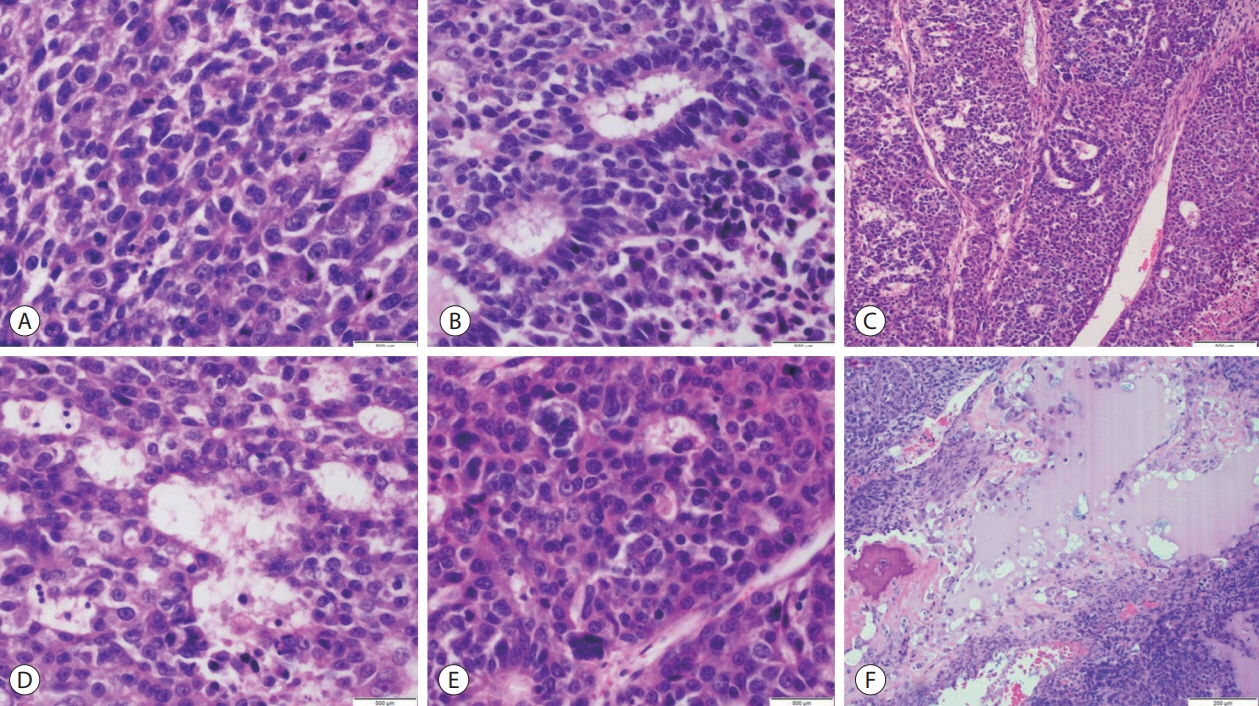J Liver Cancer.
2023 Mar;23(1):219-224. 10.17998/jlc.2023.02.24.
Adult hepatoblastoma: making the challenging distinction from hepatocellular carcinoma
- Affiliations
-
- 1Department of Pathology and Laboratory Medicine, National Kidney and Transplant Institute, Quezon City, Philippines
- KMID: 2540835
- DOI: http://doi.org/10.17998/jlc.2023.02.24
Abstract
- Hepatoblastoma is an exceptionally rare malignancy in adults with just over 70 non-pediatric cases reported in literature. Recounted is a case of a 49-year-old female who presented with acute right upper quadrant abdominal pain, elevated serum alpha fetoprotein and a large liver mass on imaging. Hepatectomy was performed under clinical suspicion of hepatocellular carcinoma. Immunomorphologic characteristics of the tumor proved consistent with hepatoblastoma of mixed epithelial and mesenchymal type. Hepatocellular carcinoma remains to be the primary differential diagnosis for adult hepatoblastoma, however, distinguishing between these two neoplasms requires close histomorphologic assessment and immunohistochemical profiling as clinical, radiologic and gross pathologic findings typically overlap. Making this distinction is highly crucial in the timely initiation of surgical and chemotherapeutic interventions for this inherently aggressive and rapidly fatal disease.
Keyword
Figure
Reference
-
References
1. Stamou C, Mitropoulou G, Pavlou K, Trihia H, Provatas I. Rare subtype of hepatoblastoma in a young adult: difficulties in the histopathological differentiation from hepatocellular carcinoma. EJMCR. 2021; 5:35–38.
Article2. Ihssan E, Hajar E, Salma B, Soumaya EC, Youssef M, Mouna K, et al. Two cases of hepatoblastoma in adults. Clin Pathol. 2022; 15:2632010. X221129592.
Article3. Paradis V, Saxena R, Quaglia A. Hepatoblastoma. In: WHO Classification of Tumours Editorial Board ed. Digestive system tumours. Vol. 1. 5th ed. Lyon: International Agency for Research on Cancer, 2019:240-244.4. Bartok I. Metastasizing hepatoblastoma in an adult. Zentralbl Allg Pathol. 1958; 98:55–60.5. Celotti A, D'Amico G, Ceresoli M, Tomasoni M, Raimondo S, Baggi P, et al. Hepatoblastoma of the adult: a systematic review of the literature. Surg Oncol. 2016; 25:339–347.
Article6. Duan XF, Zhao Q. Adult hepatoblastoma: a review of 47 cases. ANZ J Surg. 2018; 88:E50–E54.
Article7. Jeong SU, Kang HJ. Recent updates on the classification of hepatoblastoma according to the International Pediatric Liver Tumors Consensus. J Liver Cancer. 2022; 22:23–29.
Article8. Rougemont AL, McLin VA, Toso C, Wildhaber BE. Adult hepatoblastoma: learning from children. J Hepatol. 2012; 56:1392–1403.
Article9. Tsvetkova V, Magro G, Broggi G, Luchini C, Cappello F, Caporalini C, et al. New insights in gastrointestinal "pediatric" neoplasms in adult patients: pancreatoblastoma, hepatoblastoma and embryonal sarcoma of the liver. a practical approach by GIPPI-GIPAD groups. Pathologica. 2022; 114:64–78.
Article10. Tien LT, Ito M, Nakao M, Niino D, Serik M, Nakashima M, et al. Expression of beta-catenin in hepatocellular carcinoma. World J Gastroenterol. 2005; 11:2398–2401.11. Nguyen TB, Roncalli M, Di Tommaso L, Kakar S. Combined use of heat-shock protein 70 and glutamine synthetase is useful in the distinction of typical hepatocellular adenoma from atypical hepatocellular neoplasms and well-differentiated hepatocellular carcinoma. Mod Pathol. 2016; 29:283–292.
Article12. Zhuo JY, Lu D, Tan WY, Zheng SS, Shen YQ, Xu X. CK19-positive hepatocellular carcinoma is a characteristic subtype. J Cancer. 2020; 11:5069–5077.
Article
- Full Text Links
- Actions
-
Cited
- CITED
-
- Close
- Share
- Similar articles
-
- Study on the effect of various factors for the growth of human hepatocellular carcinoma, hepatoblastoma cell lines
- Fine Needle Aspiration Cytology of Hepatoblastoma: Report of Two Cases
- A Child with an Acute Abdomen due to a Ruptured Hepatoblastoma
- Minimal Change Nephrotic Syndrome Presented with Acute Renal Failure in a Child
- A case of hepatoblastoma misdiagnosed as combined hepatocellular carcinoma and cholangiocarcinoma in an adult



